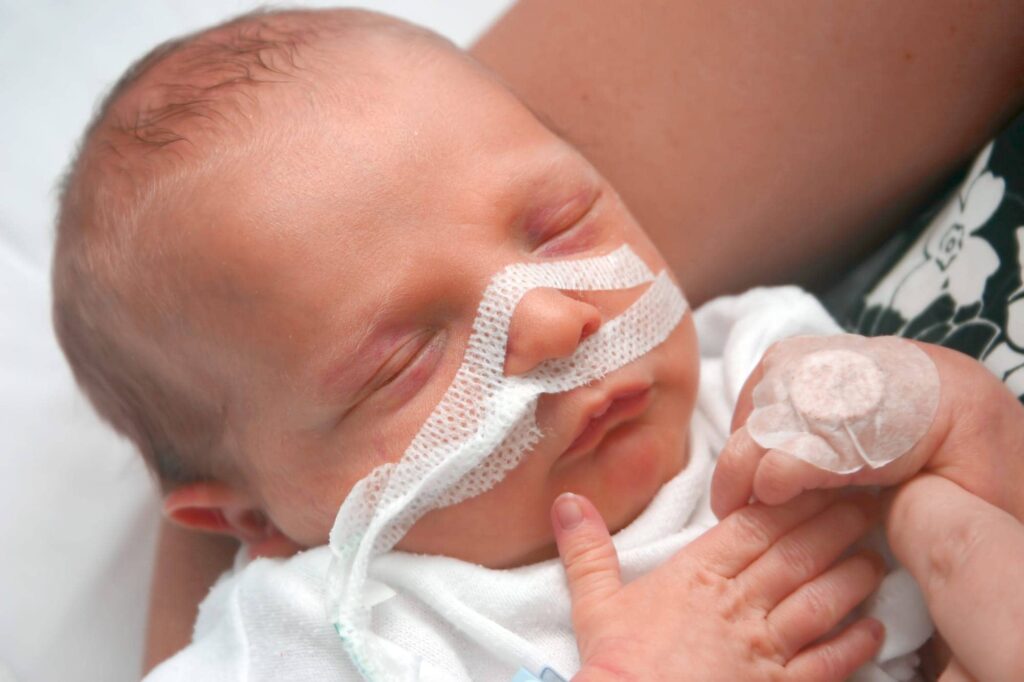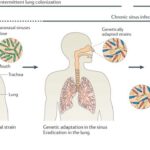Respiratory distress syndrome (RDS) in the newborn, also known as hyaline membrane disease, is a serious condition primarily affecting premature infants. It results from a deficiency of pulmonary surfactant, a crucial substance that prevents alveolar collapse by reducing surface tension within the lungs. Without adequate surfactant, newborns experience impaired gas exchange, leading to respiratory failure if left untreated.

The Critical Role of Surfactant in Neonatal Lung Function
Surfactant, produced by type II alveolar cells, begins forming around the 24th to 28th week of gestation and reaches sufficient levels by 35 weeks. Premature infants, especially those born before 32 weeks, are at highest risk for RDS due to underdeveloped lungs and insufficient surfactant production.
Pathophysiology of Respiratory Distress Syndrome
- Surfactant Deficiency → Increased alveolar surface tension
- Alveolar Collapse (Atelectasis) → Impaired oxygenation
- Ventilation-Perfusion Mismatch → Hypoxemia and respiratory acidosis
- Inflammatory Response → Formation of hyaline membranes lining the alveoli
Risk Factors for Neonatal Respiratory Distress Syndrome
- Prematurity: The most significant risk factor.
- Maternal Diabetes: Delays fetal surfactant production.
- Cesarean Delivery Without Labor: Lack of hormonal triggers that accelerate lung maturation.
- Perinatal Asphyxia: Can compromise lung function.
- Genetic Factors: Family history of RDS or inherited surfactant deficiencies.
Recognizing Clinical Signs of Respiratory Distress Syndrome
Early identification of RDS symptoms is vital for prompt intervention. Clinical signs typically manifest within minutes to a few hours after birth and may include:
- Tachypnea (respiratory rate >60 breaths per minute)
- Grunting during exhalation
- Nasal flaring
- Intercostal, subcostal, and suprasternal retractions
- Cyanosis (bluish skin discoloration)
Diagnostic Approaches for Newborn Respiratory Distress Syndrome
Clinical Evaluation
A detailed clinical assessment based on risk factors and symptomatology guides the initial diagnosis.
Radiographic Imaging
- Chest X-ray findings in RDS typically reveal a “ground-glass” appearance with air bronchograms and decreased lung volumes, indicating diffuse alveolar collapse.
Laboratory Tests
- Arterial Blood Gas Analysis: Demonstrates hypoxemia, hypercapnia, and acidosis.
- Pulse Oximetry: Continuously monitors oxygen saturation.
Management Strategies for Respiratory Distress Syndrome in the Newborn
Respiratory Support
- Supplemental Oxygen: Administered via nasal cannula or oxygen hood for mild cases.
- Continuous Positive Airway Pressure (CPAP): Maintains alveolar stability in moderate cases.
- Mechanical Ventilation: Required for severe respiratory distress or failure.
Surfactant Replacement Therapy
Early administration of exogenous surfactant dramatically improves outcomes by restoring alveolar function. It is typically delivered via an endotracheal tube.
- Prophylactic Surfactant: Given within minutes of birth for extremely preterm infants.
- Rescue Surfactant: Administered to symptomatic infants diagnosed after birth.
Supportive Care
- Thermal Regulation: Maintaining a neutral thermal environment to reduce oxygen consumption.
- Nutritional Support: Early initiation of parenteral or enteral feeding to meet increased metabolic demands.
Preventive Measures Against Respiratory Distress Syndrome
Antenatal Corticosteroids
Administered to pregnant women between 24 and 34 weeks at risk of preterm delivery, corticosteroids accelerate fetal lung maturation and surfactant production, significantly reducing the incidence and severity of RDS.
Delayed Cord Clamping
Allows for increased blood volume and improved pulmonary transition after birth, particularly beneficial in preterm infants.
Potential Complications of Neonatal Respiratory Distress Syndrome
Despite advances in therapy, RDS may lead to complications such as:
- Bronchopulmonary Dysplasia (BPD): Chronic lung disease resulting from prolonged mechanical ventilation.
- Intraventricular Hemorrhage (IVH): Bleeding into the brain’s ventricular system, particularly in very low birth weight infants.
- Pneumothorax: Air leaks into the pleural space due to barotrauma.
- Retinopathy of Prematurity (ROP): Abnormal retinal development due to high oxygen therapy.
Prognosis and Long-Term Outcomes
With timely and aggressive treatment, the majority of infants with RDS recover fully. However, extremely preterm infants may face long-term respiratory issues and developmental challenges, underscoring the importance of early intervention and multidisciplinary follow-up care.

